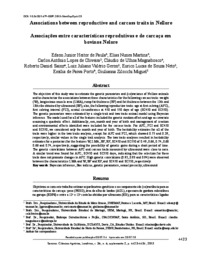Associations between reproductive and carcass traits in Nellore.
Associations between reproductive and carcass traits in Nellore.
Author(s): PAULA, E. J. H. de; MARTINS, E. N.; OLIVEIRA, C. A. L. de; MAGNABOSCO, C. de U.; SAINZ, R. D.; GERON, L. J. V.; SOUZA NETO, E. L. de; PORTO, E. de P.; MIGUEL, G. Z.
Summary: Objetivou-se com este trabalho estimar os parâmetros genéticos e os componentes de (co)variância para as características de carcaça: peso (PESO), área de olho de lombo (AOL), espessura de gordura subcutânea na garupa (EGP8) e entre a 12a e 13a costelas obtidas por ultrassom (EG); para as características ligadas à reprodução: idade ao primeiro parto (IPP), primeiro intervalo entre partos (PIEP), perímetro escrotal aos 450 e 550 dias de idade (PE450 e PE550) de animais da raça Nelore e verificar as associações entre estas características. Os parâmetros genéticos foram estimados em análises uni e bicaracter, em um modelo animal, por meio da inferência Bayesiana. O modelo utilizado, para todas as características, incluiu o efeito aleatório genético e a idade como covariável assumindo efeito quadrático. Incluiu também sexo, mês, ano de nascimento e manejo de criação como efeitos ambientais identificáveis para as características de carcaça. Para IPP, PIEP, PE450 e PE550, foram considerados apenas mês e ano de nascimento. As estimativas de herdabilidade de todas as características estudadas foram maiores nas análises bicaracter exceto para IPP e PIEP, que apresentaram 0,75 e 0,29, respectivamente, valores semelhantes nas análises unicaracter. As análises bicaracter resultaram em estimativas de herdabilidade a posteriori para as características PESO, AOL, EG, EGP8, PE450 e PE550 de 0,49, 0,66, 0,74, 0,68, 0,66 e 0,74 respectivamente, sugerindo a possibilidade de ganhos genéticos em curto prazo de tempo. As correlações genéticas entre IPP e as características de carcaça medidas por ultrassom foram próximas de zero. Comportamento semelhante foi encontrado para IPP, PE450 e PE550 dias indicando que a seleção para essas características não promoverá mudanças na IPP. Correlações genéticas altas (0,92, 0,93 e 0,94) foram encontradas entre as características AOL e PESO, EG e EGP8 e PE450 e PE550, respectivamente. ABSTRACT: The objective of this study was to estimate the genetic parameters and (co)variance of Nellore animals and to characterize the associations between these characteristics for the following carcass traits: weight (W), longissimus muscle area (LMA), rump fat thickness (RF) and fat thickness between the 12th and 13th ribs obtained by ultrasound (BF); also, the following reproductive traits: age at first calving (AFC), first calving interval (FCI), scrotal circumference at 450 and 550 days of age (SC450 and SC550). The genetic parameters were estimated by a single-trait and two traits animal model using Bayesian inference. The model used for all of the features included the genetic random effect and age as covariate assuming a quadratic effect. Additionally, sex, month and year of birth and management of creation and environmental effects identified were included for the carcass traits. For AFC, FCI and SC450 and SC550, we considered only the month and year of birth. The heritability estimates for all of the traits were higher in the two traits analysis, except for AFC and FCI, which showed 0.75 and 0.29, respectively, similar values in the single trait analysis. The two traits analyses resulted in heritability estimates for a posteriori for the features W, LMA, BF, RF, SC450 and SC550 of 0.49, 0.66, 0.74, 0.68 0.66 and 0.74, respectively, suggesting the possibility of genetic gains during a short period of time. The genetic correlations between AFC and carcass traits measured by ultrasound were close to zero. A similar trend was found for AFC, SC450 and SC550 days, indicating that the selection for these traits does not promote changes in AFC. High genetic correlations (0.92, 0.93 and 0.94) were observed between the characteristics LMA and W, BF and RF, and SC450 and SC550, respectively.
Publication year: 2015
Types of publication: Journal article
Unit: Embrapa Cerrados
Observation
Some of Embrapa's publications are published as ePub files. To read them, use or download one of the following free software options to your computer or mobile device. Android: Google Play Books; IOS: iBooks; Windows and Linux: Calibre.
Access other publications
Access the Agricultural Research Database (BDPA) to consult Embrapa's full library collection and records.
Visit Embrapa Bookstore to purchase books and other publications sold by Embrapa.

